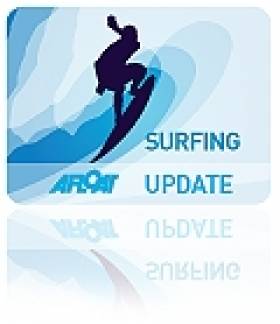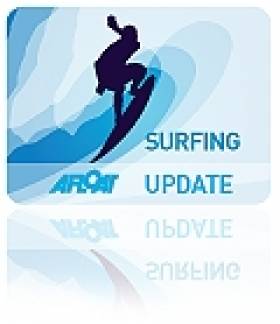Displaying items by tag: documentary
Easkey Britton Makes Waves in Iran for New Documentary
#SURFING - A documentary charting Easkey Britton's history-making surfing trip to Iran will premiere on French TV later this month, according to The Irish Times.
The hour-long film was shot by French filmmaker Marion Poizeau during the Donegal surf champion's visit in September last year to Chabahar, a coastal town in southern Iran on the Pakistan border.
Britton - of the northwest surfing dynasty - became the first woman ever to surf in Iran when she donned a full-length 'hijab swimsuit' and took to the waves in near 40 degree temperatures - attracting much attention from the locals.
“Iran is not known as a surf destination," she says, "but experiencing a country through surf gives you a different perspective. It was a leap into the unknown, but I thought I’d give it a go.”
Britton is now hoping to encourage more women and girls in the Middle East to take up surfing, noting its growing popularity in the Gaza Strip.
The Irish Times has more on the story HERE.
Lusitania Owner Rejects TV Doc Findings, Wants Second Dive
#LUSITANIA - The millionaire owner of the Lusitania shipwreck has rejected the findings of the recent TV documentary investigating the mystery of its sinking.
The Irish Independent reports that Gregg Bemis is seeking permission from the Government to mount another dive to the wreck site to "pursue the truth".
On 7 May 1915 the cruise liner RMS Lusitania was hit by a torpedo from a German U-boat off the coast of the Old Head of Kinsale in Co Cork, with the loss of 1,198 lives.
A second explosion was reported minutes later, and within 20 minutes the vessel was underwater. Only 761 people survived.
Last summer Bemis launched what was expected to be the last dive expedition to find out what really happened to the former Cunard passenger liner.
However, Bemis argues that the National Geographic documentary team behind 'Dark Secrets of the Lusitania' used "insufficient data" when they concluded that the second explosion on the vessel following a torpedo strike was from a boiler blowing up in the bowels of the ship.
He remains convinced that a secret cargo of Allied munitions was responsible for the devastating explosion that sealed the ship's fate.
"They did not have all the information they should have had," said Bemis. "They used a computer analysis to get their theory and a computer is only as good as the garbage you put in. You put garbage in, you get garbage out."
The American said only a second dive with complete access to the hull could uncover what he believes really happened - a project he hopes will take place before the Lusitania centenery.
Event to Mark Worldwide Release of 'Dark Secrets of the Lusitania'
#LUSITANIA - M3 TV Productions will be holding a special event in the Port of Cork on 14 September to mark the worldwide release of Dark Secrets of the Lusitania.
The TV documentary, which premiered last month on the National Geographic Channel, follows what might have been the last expedition to the wreck of the ill-fated cruise liner.
On 7 May 1915 the passenger liner RMS Lusitania was sunk by a torpedo from a German U-boat off the coast of Cork, with the loss of 1,198 lives. But theories abound that there was more to the disaster than the torpedo strike, and that the ship's cargo hold contained precious art and illegal munitions.
The documentary attempts to uncover what really happened, using the latest submersible technology to see further into the shipwreck than ever before.
Gregg Bemis, the US owner of the shipwreck of the former Cunard cruise liner, will be flying in for the worldwide launch event.
Other guests include representatives from the marine industry, Minister for Arts & Heritage Jimmy Deenihan, Sean Kelly MEP, Senator Deirdre Clune and representatives from the Irish Coast Guard and Naval Service.
Actors will be dressed in First World War period costume to create a special atmosphere on the evening. The Irish Examiner will also display a digital exhibition of photos on the Lusitania, while UCC's Professor Dermot Keogh will give anoverview of that tumultuous period of world history.
Irish Free Diver Pushes The Limits of The Human Body
#DIVING - An Irish free diver has told the Irish Examiner how he plunged the equivalent of a 15-storey building beneath the surface of the Red Sea on a single held breath.
Fergus Callagy's breathtaking feat is a highlight of a radio documentary about his extraordinary pastime, Fire and Water, which is available to listen on the RTÉ Radio 1 website.
The Sligo man - who says he can hold his breath for more than five minutes at a time - also recounts how he stunned experts at Sligo General Hospital by slowing his heart rate to an incredible 25 beats per minute - less than half the normal resting heart rate.
"It has been described as the most relaxing extreme sport," says Callagy of free diving, of which he is a leading light in Ireland. "When I got into [it] I started to admire what the human body can do."
The Irish Examiner has more on the story HERE.
New TV Documentary on Dark Secrets of the Lusitania
#LUSITANIA - A new TV documentary on the National Geographic Channel follows what might be the last expedition to the wreck of the Lusitania, in a bid to get to the bottom of the century-old mystery surrounding the ill-fated vessel.
On 7 May 1915 the passenger liner RMS Lusitania was sunk by a torpedo from a German U-boat off the coast of Cork, sending 1,198 lives to their doom.
But theories abound that there was more to the disaster than the torpedo strike, and that the ship's cargo hold contained precious art and illegal munitions.
Dark Secrets of the Lusitania attempts to uncover what really happened, using the latest submersible technology to see further into the shipwreck than ever before.
As previously reported on Afloat.ie, Gregg Bemis - the elderly American who owns the wreck of the former Cunard cruise liner - hoped last year to discover once and for all what secrets the ship really holds in what may be the last major dive to the wreck site.
Dark Secrets of the Lusitania premiers on Sunday 15 July at 7pm on the National Geographic Channel, available on Sky and UPC.
Cross Cultural Surfing Project Focus of New Documentary
#SURFING - WorldIrish highlights a new documentary on Cross Culture Surf, a surfing exchange programme between Ireland and the Basque Country in northern Spain.
The video above was filmed in the Irish surfing hotspot of Lahinch in Co Clare - home to big wave surfer and Billabong XXL Award nominee Ollie O'Flaherty - during the first phase of the cultural exchange in April, as 15 Irish and 15 Basque surfers got to know each other better while riding the waves.
No Tow-In Surf Session for 2012
#SURFING - The second Billabong Tow-In Surf Session will not sadly run this year, following the end of the four-month waiting period yesterday.
Organisers decided to postpone the invitation-only event till next winter after conditions off Mullaghmore Head in Co Sligo failed to reach the minimum height requirement, as Magicseaweed reports.
“We’ve had a few swells that have come close,” said contest organiser Paul O’Kane of the Irish Surf Rescue Club. “However we set the standard incredibly high with the first event and were determined to only hold the event if the conditions were as good as that, if not better.”
Magicseaweed’s Ben Freeston concurred, saying that “the conditions needed for Mullaghmore to show it’s real face are so specific you might only see them a handful of times in the best years.
“This year we have had four or five swells that were big enough to be interesting, but not quite competition standard.”
The inaugural session was organised in an effort to dispel the myth that tow-in surfing, where surfers are towed by jetski to bigger offshore waves, is an irresponsible activity.
Last year's contest was also immortalised in an upcoming documentary from Mully Productions.
Ireland's Big Wave Surfers Showcased in New Film
Ireland's first ever 'big wave' surfing contest has been immortalised in a new documentary film (SEE TRAILER BELOW).
High Pressure – The Story of Ireland’s First Big Wave Surfing Contest follows the story of those hardy souls who took on the monster waves at Sligo's Mullaghmore Head in the inaugural Tow-in Surf Session last February.
Produced, directed and edited by Dave Mottershead and Daniela Gross, the film also examines the philosophy of big-wave surfing and the value of the waves to Irish coastal communities, and is described as a "must-see and must-have" by website Surfer Today.
"Local surfers believe there are still new surf spots to be found and challenged on the Irish coast," the site adds, noting that the film "opens the professional book of surfing in Ireland".
For further enquiries regarding High Pressure – The Story of Ireland’s First Big Wave Surfing Contest, contact [email protected].
Waterways Returns to the Screen This Sunday
Waterways returns to RTÉ television after 16 years off the air this coming Sunday.
The original award-winning 1990s documentary series saw naturalist and poet Dick Warner undertake an epic journey traversing the canals of Ireland by barge.
This year filmmaker Stephen Rooke accompanied Warner as he returned to our inland waterways, this time to explore the newly restored Royal Canal and celebrate the reopening of the entire route from Dublin to the Shannon.
As previously reported on Afloat.ie, Warner travels on the Rambler, an original canal tug barge, from Dublin to Lough Ree - the first time it had followed the route since 1923.
Along the way, Warner meets both experts and ordinary people who live along the banks, learning from them about its heritage, history and wildlife.
Filming is now complete on the new six-part series, Waterways - A Royal Canal, which begins this Sunday night.
According to Irish Film and Television News, Rooke re-assembled the core team from the original series, many of whom have gone on to work on successful films and TV shows.
The series begins on RTÉ One at 8.30pm on Sunday 2 October.
The latest issue of Canoe & Kayak magazine takes in-depth look into sea kayakers Jeff Allen and Harry Whelan's record breaking circumnavigation of Ireland.
The final 225 miles of the voyage were completed in an incredible three days - a challenge that pushed the experiences kayakers to their physical and mental limits.
But the reward was a new speed record for kayaking round Ireland in just 24 days.
As previously reported on Afloat.ie, a documentary on the duo's feat is currently in the works.

































































